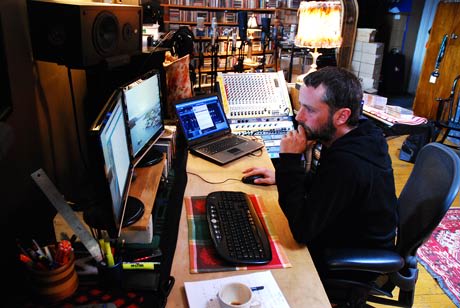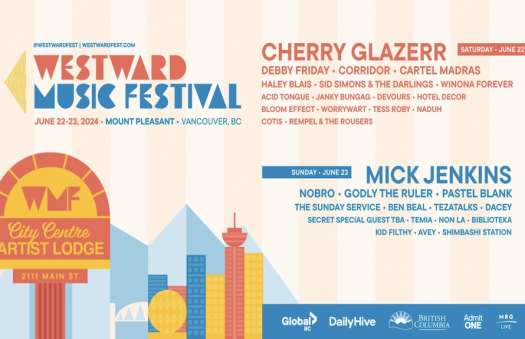Former industrial lands are notorious for being colonized by artists. This is particularly true of Montreal, but Toronto has seen its fair share of artsy activity in abandoned downtown buildings. Torontos artists districts of this type are in decline, reclaimed by condos or awaiting further development, yet a few holdouts remain.
The southern stretch of Sterling Road is one example. Theres a pleasing ratio of fully to partly demolished factories alongside reclaimed artist spaces and there are plenty of moody concrete piazzas for inspiration. The southern edge of one of these blank concrete fields is where youll find Jean Martins Farm.
Martin is a drummer and engineer whose studio (and label, Barnyard Records) has become a focal point of the bustling Toronto improvisers scene over the past several years. He explains: "The Farm comes from when Christine [Duncan, singer] and I lived in an abandoned farm, in Burlington, ON. We were there for about a year, and the name stuck even when we moved in town. Now the property has been bought by rich people to house fancy cars and spoiled kids, probably. That may well happen on Sterling Road, but condos arent baying at his door just yet.
Martins live/work space is a haven from the bleakness outside. Its a typical single room loft space whose walls are crammed with CDs, books and records. Being part of the top floor, the room benefits from the pleasant glow of a skylight. A grey cat and several dozen dolls of various cultural origins yes, its funny/creepy preside over the space. Beautiful hardwood floors dominate, and the stuff of everyday life is the only sound insulation. Theres no control room, isolation booth or acoustic tile anywhere. Youd hardly know this was a studio were it not for the discreet rack of gear and telltale dual computer monitors that scream "professional artist although his Nuendo recording platform runs on a PC, not a Mac. Hes never had any problems working on PC, and its much less expensive. The Farm is as much about composition as recording. Martin often has a collaborative role, either as a player or an engineer, in Farm projects. Most Barnyard releases contain a fair bit of studio craft verging on out and out dub mixing, in stark contrast to the verité approach to recording of most free improv releases. Martin believes that if you want to hear what a band sounds like, go see them live, but a recording session should be about using the studio creatively. "I always believe that a record should be a piece of art, he asserts.
He has hosted all manner of groups in this one-room space, from straight up pop bands to ensembles like the Reveries, who utilize street sweeper bristles as their bass noises. The lack of sound baffling is less important to him and his clients than the overall comfort level of the space. Even if things get loud, hell just adjust the microphones to make sure everyone gets recorded properly. The space has its limitations, he admits. "I wouldnt record a drum set and a cello in here at the same time. Hell work out of a studio like Canterbury sound if he needs to track instruments in a more isolated setting, but will mix them at home.
In addition to providing a recording environment with more personality than the typical studio beige, the studio experience here is not governed by the clock, which Martin believes greatly frees up an artist to do their best work. "Its nice to be in a place where we can take a week to really play. Lets not have any of the weird feelings that we usually have in the studio, says Martin "Usually, there are headphones, we cant really hear each other, were not really in control of all the elements. Here theres no pressure. We can go out and have a coffee. Theres no money pressure. Thats the nice thing about being in a place like this, plus its my place.
Theres a danger in over-personalizing the space too, and Martin knows it. "Im not really trying to make something sound like me. I like to at least be open enough to accept the sound thats there, and to enhance it. I dont really have an aesthetic.
If this composing/recording situation sounds familiar to regular Where I Play readers, it is. Martin is friends with Vancouvers Jesse Zubot (Where I Play, August 2007), and has collaborated with the experimental West coast violinist. "There are similarities for sure, says Martin. "Hes not afraid of making stuff sound different. I try to create a new space when Im making art, and I think hes into that.
As with Zubots recording and Drip Audio label, Martin feels that having a recording environment that fosters full expression as well as creative collaboration is a major catalyst to Torontos improvising scene. Martin has noticed a positive shift among musicians and notes with pride "Its been a little weird in this town for recording. The people making improvised music werent really thinking about recording, and now theyre thinking about making records, not just documenting a performance.
The southern stretch of Sterling Road is one example. Theres a pleasing ratio of fully to partly demolished factories alongside reclaimed artist spaces and there are plenty of moody concrete piazzas for inspiration. The southern edge of one of these blank concrete fields is where youll find Jean Martins Farm.
Martin is a drummer and engineer whose studio (and label, Barnyard Records) has become a focal point of the bustling Toronto improvisers scene over the past several years. He explains: "The Farm comes from when Christine [Duncan, singer] and I lived in an abandoned farm, in Burlington, ON. We were there for about a year, and the name stuck even when we moved in town. Now the property has been bought by rich people to house fancy cars and spoiled kids, probably. That may well happen on Sterling Road, but condos arent baying at his door just yet.
Martins live/work space is a haven from the bleakness outside. Its a typical single room loft space whose walls are crammed with CDs, books and records. Being part of the top floor, the room benefits from the pleasant glow of a skylight. A grey cat and several dozen dolls of various cultural origins yes, its funny/creepy preside over the space. Beautiful hardwood floors dominate, and the stuff of everyday life is the only sound insulation. Theres no control room, isolation booth or acoustic tile anywhere. Youd hardly know this was a studio were it not for the discreet rack of gear and telltale dual computer monitors that scream "professional artist although his Nuendo recording platform runs on a PC, not a Mac. Hes never had any problems working on PC, and its much less expensive. The Farm is as much about composition as recording. Martin often has a collaborative role, either as a player or an engineer, in Farm projects. Most Barnyard releases contain a fair bit of studio craft verging on out and out dub mixing, in stark contrast to the verité approach to recording of most free improv releases. Martin believes that if you want to hear what a band sounds like, go see them live, but a recording session should be about using the studio creatively. "I always believe that a record should be a piece of art, he asserts.
He has hosted all manner of groups in this one-room space, from straight up pop bands to ensembles like the Reveries, who utilize street sweeper bristles as their bass noises. The lack of sound baffling is less important to him and his clients than the overall comfort level of the space. Even if things get loud, hell just adjust the microphones to make sure everyone gets recorded properly. The space has its limitations, he admits. "I wouldnt record a drum set and a cello in here at the same time. Hell work out of a studio like Canterbury sound if he needs to track instruments in a more isolated setting, but will mix them at home.
In addition to providing a recording environment with more personality than the typical studio beige, the studio experience here is not governed by the clock, which Martin believes greatly frees up an artist to do their best work. "Its nice to be in a place where we can take a week to really play. Lets not have any of the weird feelings that we usually have in the studio, says Martin "Usually, there are headphones, we cant really hear each other, were not really in control of all the elements. Here theres no pressure. We can go out and have a coffee. Theres no money pressure. Thats the nice thing about being in a place like this, plus its my place.
Theres a danger in over-personalizing the space too, and Martin knows it. "Im not really trying to make something sound like me. I like to at least be open enough to accept the sound thats there, and to enhance it. I dont really have an aesthetic.
If this composing/recording situation sounds familiar to regular Where I Play readers, it is. Martin is friends with Vancouvers Jesse Zubot (Where I Play, August 2007), and has collaborated with the experimental West coast violinist. "There are similarities for sure, says Martin. "Hes not afraid of making stuff sound different. I try to create a new space when Im making art, and I think hes into that.
As with Zubots recording and Drip Audio label, Martin feels that having a recording environment that fosters full expression as well as creative collaboration is a major catalyst to Torontos improvising scene. Martin has noticed a positive shift among musicians and notes with pride "Its been a little weird in this town for recording. The people making improvised music werent really thinking about recording, and now theyre thinking about making records, not just documenting a performance.




